
The MIM-104 Patriot is a surface-to-air missile (SAM) system, the primary of its kind used by the United States Army and several allied nations. It is manufactured by the U.S. defense contractor Raytheon and derives its name from the radar component of the weapon system. The AN/MPQ-53 at the heart of the system is known as the "Phased Array Tracking Radar to Intercept on Target" which is a backronym for PATRIOT. The Patriot System replaced the Nike Hercules system as the U.S. Army's primary High to Medium Air Defense (HIMAD) system, and replaced the MIM-23 Hawk system as the U.S. Army's medium tactical air defense system. In addition to these roles, Patriot has been given the function of the U.S. Army's anti-ballistic missile (ABM) system, which is now Patriot's primary mission. The system is expected to stay fielded until at least 2040.

Rapier is a surface-to-air missile developed for the British Army to replace their towed Bofors 40/L70 anti-aircraft guns. The system is unusual as it uses a manual optical guidance system, sending guidance commands to the missile in flight over a radio link. This results in a high level of accuracy, therefore a large warhead is not required.

An active electronically scanned array (AESA) is a type of phased array antenna, which is a computer-controlled array antenna in which the beam of radio waves can be electronically steered to point in different directions without moving the antenna. In the AESA, each antenna element is connected to a small solid-state transmit/receive module (TRM) under the control of a computer, which performs the functions of a transmitter and/or receiver for the antenna. This contrasts with a passive electronically scanned array (PESA), in which all the antenna elements are connected to a single transmitter and/or receiver through phase shifters under the control of the computer. AESA's main use is in radar, and these are known as active phased array radar (APAR).

A military artillery observer,spotter or FO is responsible for directing artillery and mortar fire onto a target and may be a Forward Air Controller (FAC) for close air support and spotter for naval gunfire support. Also known as Fire Support Specialist or FISTer, an artillery observer usually accompanies a tank or infantry manoeuvre unit. Spotters ensure that indirect fire hits targets which the troops at the fire support base cannot see.

The 2K11 Krug is a Soviet and now Russian medium-range, medium-to-high altitude surface-to-air missile (SAM) system. The system was designed by NPO Novator and produced by Kalinin Machine Building Plant. Its GRAU designation is "2K11." Its NATO reporting name is SA-4 Ganef, after a word of Yiddish origin meaning "thief" or "rascal."
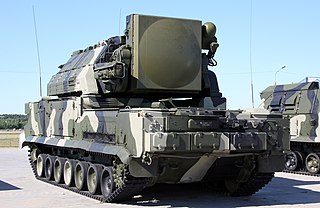
The Tor missile system is an all-weather low to medium altitude, short-range surface-to-air missile system designed for engaging airplanes, helicopters, cruise missiles, precision guided munitions, unmanned aerial vehicles and short-range ballistic threats (Anti-Munitions). Originally developed by the Soviet Union under the GRAU designation 9K330 Tor, the system is commonly known by its NATO reporting name, SA-15 "Gauntlet". A navalized variant was developed under the name 3K95 "Kinzhal", also known as the SA-N-9 "Gauntlet". Tor was also the first air defence system in the world designed from the start to shoot down precision guided weapons like the AGM-86 ALCM day and night, in bad weather and jamming situations. Tor can detect targets while on the move. The vehicle must stop intermittently when firing, although trials are being conducted to eliminate this restriction.

A counter-battery radar is a radar system that detects artillery projectiles fired by one or more guns, howitzers, mortars or rocket launchers and, from their trajectories, locates the position on the ground of the weapon that fired it. Such radars are a subclass of the wider class of target acquisition radars.

The Raytheon MIM-23 Hawk is an American medium-range surface-to-air missile. It was designed to be a much more mobile counterpart to the MIM-14 Nike Hercules, trading off range and altitude capability for a much smaller size and weight. Its low-level performance was greatly improved over Nike through the adoption of new radars and a continuous wave semi-active radar homing guidance system.

Rajendra is a passive electronically scanned array radar developed by the Defence Research and Development Organisation (DRDO), an agency of the Republic of India. It is a multifunction radar, capable of surveillance, tracking and engaging low radar cross section targets. It is the heart of the Akash surface-to-air missile system and is the primary fire control sensor for an Akash battery.
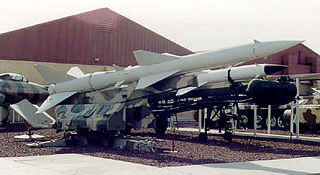
The S-75 is a Soviet-designed, high-altitude air defence system, built around a surface-to-air missile with command guidance. Following its first deployment in 1957 it became one of the most widely deployed air defence systems in history. It scored the first destruction of an enemy aircraft by a surface-to-air missile, with the shooting down of a Taiwanese Martin RB-57D Canberra over China on 7 October 1959 that was hit by a salvo of three V-750 (1D) missiles at an altitude of 20 km (65,600 ft). This success was credited to Chinese fighter aircraft at the time in order to keep the S-75 program secret.
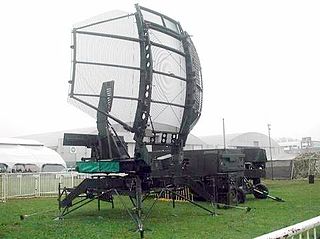
The AN/TPS-43 is a transportable air search 3D radar produced in the United States originally by Westinghouse Defense and Electronic Division, which was later purchased by Northrop-Grumman.
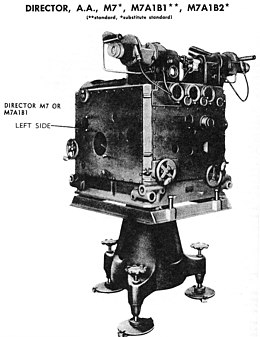
A director, also called an auxiliary predictor, is a mechanical or electronic computer that continuously calculates trigonometric firing solutions for use against a moving target, and transmits targeting data to direct the weapon firing crew.
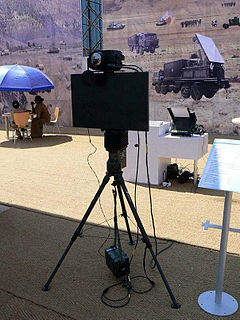
The PJT-531 Battle Field Surveillance Radar – Short Range(BFSR-SR) is a man portable 2D short-range battlefield and perimeter surveillance radar developed by the Indian Defence Research and Development Organisation (DRDO). The BFSR has been designed by DRDO's Bangalore-based laboratory, the Electronics and Radar Development Establishment (LRDE) and is being manufactured by Bharat Electronics Limited (BEL).

Highlands Air Force Station was a military installation in Middletown Township near the borough of Highlands, New Jersey. The station provided ground-controlled interception radar coverage as part of the Lashup Radar Network and the Semi-Automatic Ground Environment network, as well as providing radar coverage for the Highlands Army Air Defense Site. The site's 240 acres (97 ha) is now the Rocky Point section in Hartshorne Woods Park of the Monmouth County Parks System.
The Martin AN/FSG-1 Antiaircraft Defense System, better known as Missile Master, was an electronic fire distribution center to computerize Cold War air defense (AD) command posts from manual plotting board operations to automated command and control of remote surface-to-air missile (SAM) launch batteries. The 10 United States Army C3 systems used radar netting ("electronic umbrella") at Missile Master military installations for coordinating ground-controlled interception by Nike and MIM-23 Hawk missiles. The vacuum tube fire control logic reduced the time to designate the appropriate missile battery to launch if an enemy target had intruded into a defense area where an AN/FSG-1 system was deployed.

120 Squadron SAAF was a South African Air Force squadron formed in 1970 to operate the South African/French Cactus surface-to-air missile systems in an air defence role. The unit was disbanded when the Cactus system was retired from service in the late 1980s.
The AN/GSS-1 Electronic Search Central was a United States radar/communication system 1st fielded in the mid-1950s for Project Nike with a "medium-range, transportable radar set [used] as a search radar". The Cold War central included a Western Electric "AN/TPS-1D radar and AN/TPX-19 interrogator system…in a fully enclosed shelter [with communications] provided by radio receiving set AN/GRR-5, radio set AN/GRC-9 and by three telephone lines". An intercom system for the "four-man team" was within the shelter of "about 6 feet high, 6 feet wide and 12 feet long" with a "personnel area [and] equipment compartment".
The Western Electric M-33 Antiaircraft Fire Control System was an X-Band "Gunfire Control Radar", for aiming antiaircraft artillery by computer control. Developed for mobility via 3 trailers, the "M-33 system could compute, for the 90-mm. and 120-mm. guns, firing data for targets with speeds up to 1,000 mph", and for targets at 120,000 yards had similar gun laying accuracy as "SCR-584 type radars" at 70,000 yards. The system included a telescopic "target selector" on a tripod near the guns for additional measurement of aircraft "azimuth and elevation data [to] be transmitted to the computer and utilized as gun directing data."

The Super Fledermaus, known in Swiss service as the Feuerleitgerät 63, Flt Gt 63, is a pulse-radar fire control system, 111 of these systems were in service with the Swiss Air Force from 1965 to 1977. Under the lead of Contraves, the Super Fledermaus fire control system was jointly developed and produced by ten companies. It replaced the Fire control radar Mark VII in Swiss service, and was in turn replaced by the Skyguard system.





















